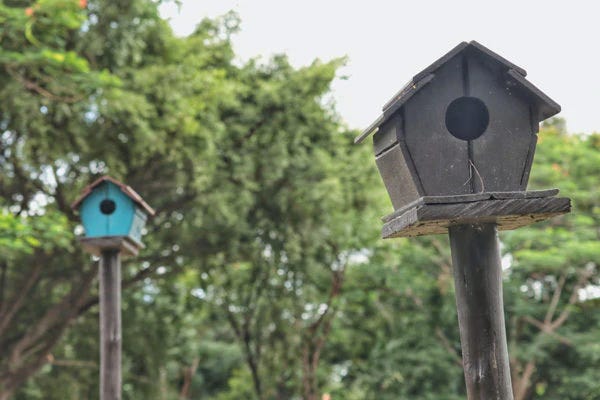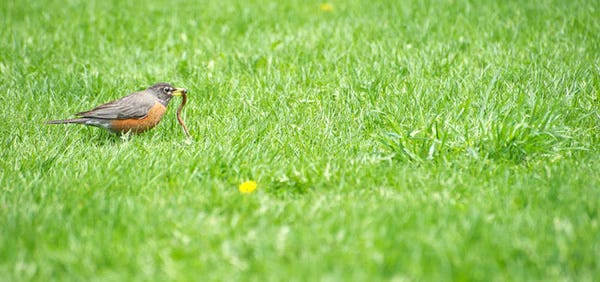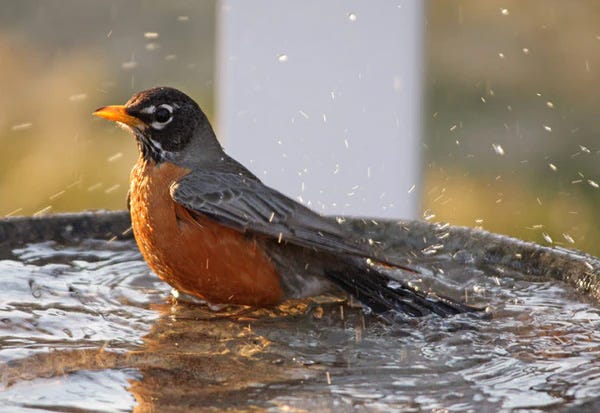
The American Robin is a common sight on lawns across the country, recognized by their jaunty little hopping movements. For the early riser, a glance out the window might very well reward them the chance to watch a reddish-orange breasted bird tugging a worm from the lawn for breakfast. Their cheerful song is a welcome sound that many people equate with the arrival of spring.
Between their lively hopping antics and melodic sounds, it’s no wonder most birdwatchers want to attract them to their backyard feeders. There is no better time than the spring to make your backyard a habitat for robins.

Home Sweet Home: The Nest Box
While robins do not mate for life, it isn’t uncommon for a male and female who had mated the previous season to return to the same territory or nest box to mate again. This is especially common when a male and female have had success raising babies the previous season. Your first step in attracting robins is to put up a nest box. Whether you choose to buy or build your nest box, keep these important tips in mind:
- Wood is the best material for your nest box. It breathes, is durable, and offers insulating qualities. Cedar and redwood are good decay-resistant choices. Choose wood that is at least ¾” thick to avoid heat buildup, which is harmful to young birds.
- Paint the outside of the nest box using paints that aren’t lead-based. Nest boxes will last longer when coated with a water-based exterior latex paint. Dark natural colors not only help camouflage the nest box but also prevent wood from rotting. The inside of the nest box should be left natural.
- Drainage holes should be present and small enough to release moisture. Ventilation should be allowed for under the roof easement to allow for adequate airflow but preventing rain from getting in.
- Place the nest box so that the entrance hole faces north-east and is sheltered from the wind and rain. South facing walls tend to be heat traps that could make the nest box dangerously hot. Ideally, the nest box should be within some vegetation or climbing plant as Robins tend to nest low, often within only 6 feet from the ground.

Feeding Time: What to Feed Robins
Providing a source of nutrition for robins is not as simple as filling a feeder with seeds.
Robins do not eat the foods that are common to most feeders. Robins feast on worms they dig out from lawns, and natural food sources you can grow in your own yard. Consider juniper hedges that produce berries that can be planted to create a natural border in your yard. Cherry trees, as well as crabapple trees, not only are aesthetically pleasing, but also offer nutritious fruit that robins can consume. Most people have seen the image of a robin with a holly berry clutched in his bill. Holly bushes finish the look of a garden bed and offer another attractive source of nutrition for robins.
You can also help make the robin’s hunt for worms more productive simply by watering the lawn early in the morning. This will prod earthworms to the surface. Keeping the lawn short will also make combing for worms easier. Pesticide use is always discouraged anywhere birds are nesting and eating. Avoiding pesticides invites robins to naturally eliminate garden pests for you.
See also: Birdscaping: 10 Tips for How to Attract More Birds
Make a Splash: Add a Water Feature
Like most birds, robins readily come to water. Offering robins a source of water might be the easiest way for them to find the food you are offering.
Birds need fresh clean water, and providing it isn’t difficult or complicated. There are several different types of water sources to consider when trying to attract robins to your backyard.
The two main reasons birds need water are basic—for drinking and grooming. Like humans, drinking water helps birds stay cool and hydrated. Bathing helps remove dust and loose feathers. Birds that would normally pass over a yard with a feeder can be lured by the sounds of running water. While a birdbath is better than no water at all, moving water features catch both the bird’s ears and eyes. A bird’s keen hearing will alert them to splashing water in the distance, tempting them to land and seek out the source.
See also: 8 Things You Should Know Before Installing a Bird BathSafety First
As you avoid pesticides on your lawn to keep robins safe, do not add any chemicals to any of the water sources you choose for your backyard. Keeping your bird bath clean by scrubbing it weekly with a wire brush as well as regularly cleaning other water features is safest for all birds.
Spring is the perfect time to work on attracting robins to your yard. With these simple steps, you will soon be enjoying these bright breasted, cheery songbirds hopping about your backyard. What better sight to see as you throw open the blinds on a sunny spring morning and get ready to start your day.







